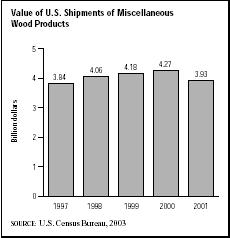SIC 2499
WOOD PRODUCTS, NOT ELSEWHERE CLASSIFIED
This category includes establishments primarily engaged in manufacturing miscellaneous wood products, not elsewhere classified, and products made from rattan, reed, splint, straw, veneer, veneer strips, wicker, and willow.
NAICS Code(s)
339999 (All Other Miscellaneous Manufacturing)
321920 (Wood Container and Pallet Manufacturing)
321999 (All Other Miscellaneous Wood Product Manufacturing)

The industry covers a plethora of wood products not categorized under other classifications, such as ship masts, dowels, rowboat oars, clipboards, rattan seat covers, shoe trees, tool handles, toothpicks, washboards, paint stirring sticks, and wooden ladders. Although the breadth of this industry is enormous, some categories account for a significant portion of overall sales. For example, wooden picture and mirror frames are by far the largest category.
Individuals, the largest consumers of miscellaneous wooden goods, account for the largest percentage of industry sales. Office building owners and managers were the second-largest sector. Other major consumers of industry output were furniture manufacturers, makers of glass products, and paperboard mills.
This industry is intangible and unstructured compared with most other industrial categories. The industry experienced wide swings in revenues during the 1980s, according to the U.S. Census of Manufacturers. At that time 3,400 firms reported total sales of $3.4 billion. By 1992, the Census reported only 2,644 firms having $3.7 billion in total shipments of miscellaneous wooden items. By 1997, the number of firms had dropped to roughly 2,300 with a value of shipments of approximately $3.7 billion. The value of shipments increased to $4.27 billion in 2000, before dropping to $3.93 billion in 2001.
Long-term growth in industry sales and profits is dependent on individual product segments. Overall employment was expected to decline significantly between 1990 and 2005, according to the Bureau of Labor Statistics. Assembler and fabricator jobs, for example, could plummet by more than 26 percent; positions for machine operators and bookkeepers also could decline. Most occupations were anticipated to realize a 5 to 20 percent reduction in the workforce as companies sought to automate and increase productivity. Sales and marketing professionals, in contrast, should see positions in this industry grow by nearly 20 percent.
The largest producer of miscellaneous wood products throughout the first half of the 1990s was Masonite Corp. of Illinois, although the company's revenue and number of employees declined sharply during that period. Masonite Corp. generated revenue of $264 million from its diversified operations in 1996 and employed about 3,000 workers, down from revenue of $535 million and a workforce of 5,000 people in 1991. Masonite Corp. fell to second behind Longaberger Co. of Dresden, Ohio (with sales of $500 million), even though its sales grew to more than $400 million in 1997. In 2002, International Paper sold Masonite to Ontario, Canada-based Premdor Inc., which changed its name to Masonite International Corp. Longaberger posted sales of $906 million in 2002.
Other companies with sales of more than $200 million included ABT Building Products Corporation of Neenah, Wisconsin, which was acquired by Louisiana-Pacific Corp. in 1999; ABTCO of Troy, Michigan, also a subsidiary of Louisiana-Pacific; Simpson Manufacturing Co. Inc. of Pleasanton, California; Intercraft Co. of Taylor, Texas; and Larson-Juhl, of Ashland, Wisconsin, which was acquired by Berkshire Hathaway Inc. in 2002.
An estimated 44,931 workers served the industry in 2000, reflecting an overall decline from the 61,000 workers reported in 1987, despite an increase from the 43,678 workers reported in 1997. Production workers comprised 82 percent of employees. These workers earned less than $10 per hour. Significant occupations in this industry include assemblers and fabricators, machine operators, sawyers, blue-collar work supervisors, and truck drivers.
Further Reading
U.S. Census Bureau. "Statistics for Industry Groups and Industries: 2000." February 2002. Available from http://www.census.gov/prod/2002pubs/m00as-1.pdf .
——. "Value of Shipment for Product Classes: 2001 and Earlier Years." December 2002. Available from http://www.census.gov/prod/2003pubs/m01as-2.pdf .
Comment about this article, ask questions, or add new information about this topic: